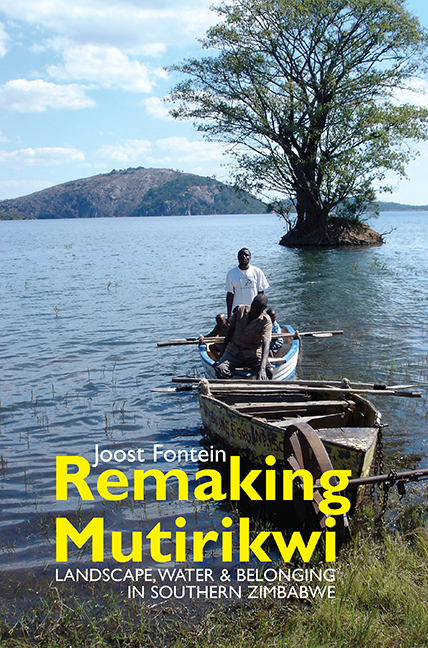Book contents
- Frontmatter
- Dedication
- Contents
- Illustrations
- Acknowledgements
- Note on Fieldwork, Notes & Sources
- Glossary
- Acronyms & Abbreviations
- Chronology
- Remaking Mutirikwi: An Introduction
- Part One Remaking Mutirikwi in the 2000s
- Part Two Damming Mutirikwi 1940s–1990s
- Epilogue: Remaking Mutirikwi in the late 2000s & early 2010s
- Bibliography
- Index
- Eastern African Studies
5 - Genealogical Geographies
Published online by Cambridge University Press: 11 June 2021
- Frontmatter
- Dedication
- Contents
- Illustrations
- Acknowledgements
- Note on Fieldwork, Notes & Sources
- Glossary
- Acronyms & Abbreviations
- Chronology
- Remaking Mutirikwi: An Introduction
- Part One Remaking Mutirikwi in the 2000s
- Part Two Damming Mutirikwi 1940s–1990s
- Epilogue: Remaking Mutirikwi in the late 2000s & early 2010s
- Bibliography
- Index
- Eastern African Studies
Summary
After 2000, land occupations around Mutirikwi meant disputes between rival chiefs and clans over boundaries, people and ‘ancestral territories’ re-emerged with new immediacy. These related directly to reimagined and re-membered pre-colonial landscapes, involving contested ‘history-scapes’ (Fontein 2006a:19) and what I shall call ‘genealogical geographies’. In 2005/06 such disputes were particularly prominent on occupied state lands bordering the lake's southern shores, which had been subject to squatting, and in some places formal resettlement, in the 1980s. But they also took place on farms to the north being resettled for the first time, as well as to the east around Zano, which had ‘reverted’ to native reserve in the late 1950s to settle people removed for the dam.
At Boroma, the grazing areas of mhinda mirefu (long fields) resettlements and an irrigation scheme from the 1980s were re-occupied in 2002 by the late Chief Mudarikwa Murinye and his people, provoking new boundary disputes with Chief Mugabe. As territorial markers rivers featured prominently (especially the inundated Mutirikwi river), as did the graves and ruins of past occupations and new burials, such as Mudarikwa's own burial in 2004. With prevailing droughts these disputes also reverberated through the distribution of food aid, as chiefly territories were conflated with new ward boundaries, and hungry people crossed disputed boundaries to seek assistance from whoever was able to source it. Not far from Boroma, Chief Mugabe placed settlers on state lands between the lakeshore and parts of former Mzero and Le Rhone farms, a section of the lake's protective boundary zone later earmarked for the Great Zimbabwe University. Besides his own clan these settlers included vatorwa incomers, some of whom became sabhuku (village heads) as the chief tried to increase these under his jurisdiction to bolster his status among local rivals. In a contiguous stretch of land between the lake and Great Zimbabwe, long-standing tensions between Mugabe, Nemanwa and Charumbira, as well as within the Mugabe clan, re-emerged as various Haruzvivishe ‘houses’ (particular branches or families within the clan) re-occupied lands they had been removed from twice before: by Morgenster mission in the 1940s and 1950s, and by the independent government after earlier re-occupations in the 1980s. Further west, around the Longdale irrigation scheme below Ruvuri mountain, boundary tensions re-emerged between Nemanwa and Charumbira, until the former's new headman was granted land to live on by Chief Charumbira in late 2005.
- Type
- Chapter
- Information
- Remaking MutirikwiLandscape, Water & Belonging in Southern Zimbabwe, pp. 139 - 168Publisher: Boydell & BrewerPrint publication year: 2015

